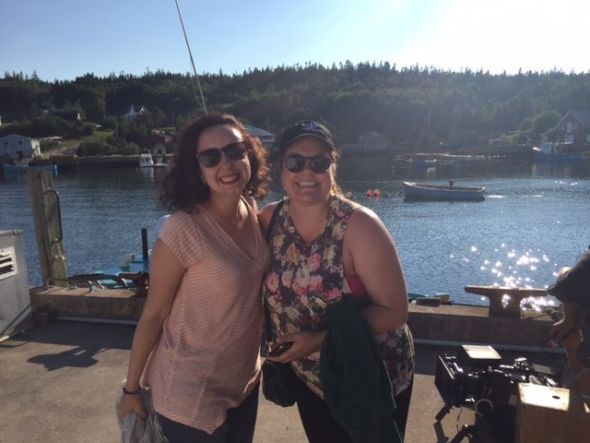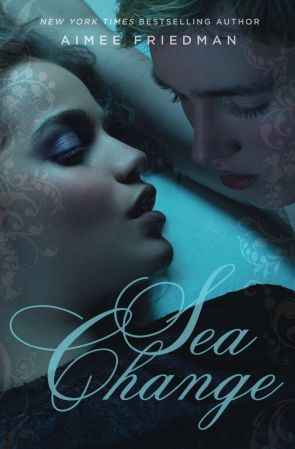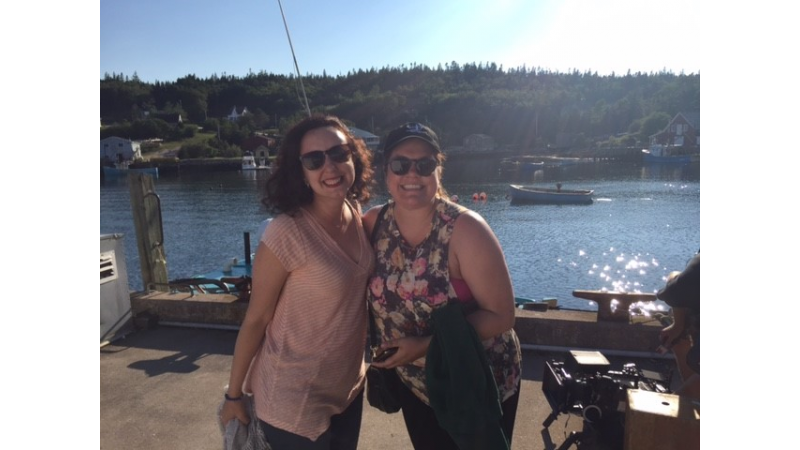 Sea Change was released into the world in 2009, and now, television viewers can watch it on Lifetime! Below, the New York Times bestselling author of Sea Change, Aimee Friedman, talks with Liz Sczudlo, one of the writers of the “Sea Change” movie. Check your local listings!
Sea Change was released into the world in 2009, and now, television viewers can watch it on Lifetime! Below, the New York Times bestselling author of Sea Change, Aimee Friedman, talks with Liz Sczudlo, one of the writers of the “Sea Change” movie. Check your local listings!
Aimee Friedman: Hi Liz! First of all, thank you so much for doing such a fabulous job adapting my novel Sea Change into an amazing screenplay. It was such a thrill to read the screenplay. Can you talk a little bit about what the process of writing a screenplay is like?
Liz Sczudlo: Thanks for trusting me with your work! It was such an honor to take your novel and figure out how to adapt it for television without losing any of the elements that made it so compelling.
AF: Aww, now I’m blushing!
LS: Writing any two teleplays (what we call scripts in television) is never the same for me. Sometimes, I start with strong characters and have to figure out into what crazy situation I want to drop them. Sometimes, I start with a strong central premise, then have to work backwards to populate that story with authentic and interesting characters. But usually I start with the big picture concept – what am I trying to say with the story? What’s the character’s journey fundamentally about? I’ve found that every time I’ve tried to write a script without understanding the big picture idea, I’ve failed.
AF: I hear that. It rings very true for the process of writing novels as well.
LS: In the case of “Sea Change,” it was the first time I’d been tasked with adapting a novel for television and it went through a lot of iterations before we landed where we did. I really wanted to respect the strength of the book’s characters while honoring the pitch that the producers had gone to the network with – a delicate balancing act. I think in general, novels have permission to move more slowly than television shows. You have the benefit of internal monologue to keep the reader compelled when the action slows down. But in TV, the pace is quick quick quick. And so I had to figure out how to take this incredible and mysterious world you built and accelerate the plot so it felt like it was paced for TV.
AF: It’s true that Miranda in the book does lots of thinking (about life, love, sea creatures…), and short of a voiceover, it’s hard to translate that to the screen. You pulled it off so well!
LS: Thank you! The other tricky piece of this script was figuring out the rules of the universe. So I spent weeks digging deeper into the hows and whys of the sea creatures. Having never worked on a genre piece before, this was a big challenge!
 AF: So, I got to spend some time on the “Sea Change” set, which was an incredible experience. (If you’ll recall, I couldn’t stop taking pictures or saying “This is so surreal.”). And you were on set for the whole duration of filming! What was that like?
AF: So, I got to spend some time on the “Sea Change” set, which was an incredible experience. (If you’ll recall, I couldn’t stop taking pictures or saying “This is so surreal.”). And you were on set for the whole duration of filming! What was that like?
LS: I spent all summer in Nova Scotia filming, and it was simultaneously the most amazing and the most challenging shoot of my career. I’ve covered a ton of shows that film on sound stages, where you can control everything from the angle of the “sun” to the ambient noise on set. The “Sea Change” sets were 100% locations, which meant we often had little control over things like noise and weather. We had a very short shooting schedule – I still marvel at the fact that we got as much footage as we did. It was in part due to the amazing crew up in Nova Scotia (you won’t find harder workers anywhere) that we were able to get huge amounts of work done in very little time.
AF: I hadn’t even though about the weather issue, and it’s true—for instance, I remember one day when the cast and crew had to spend a lot of time in the ocean, and the water was freezing. I couldn’t have done it!
LS: One of the other trials of shooting in rural NS was that we were far from any rental house – if a set light broke, we couldn’t replace it until the next day. There were also challenges with wardrobe. The nearest mall was hours away. Unlike shoots in LA, we couldn’t bring the cast in two weeks early for multiple wardrobe fittings. We had to hope that the sizes they sent us were accurate and that the clothes our wardrobe department purchased would work with the actors’ body-types. In a few cases, the clothes didn’t work and we really had to scramble to be creative. But our cast and costumers were game and it all worked out in the end. Overall, shooting “Sea Change” was an enormously positive experience. Nova Scotia might actually be paradise; it’s the prettiest place I’ve ever worked.
AF: I know. I want to move to “Selkie Island.”
LS: And I’ll never get used to the magic of describing a physical space on paper and then walking on set to find the talented art department has brought that space to life. Our director, Chris Grismer, was incredible. He had such a strong vision and it was really powerful to watch it unfold. Our cinematographer, Jackson Parrell, is an absolute genius behind the camera and I’ve never been more proud of the look of a show. And I can’t say enough positive things about our cast. There’s a real joy in working with younger actors who pour their hearts and souls into the gig. Our cast was passionate and brought 100% with them every day. You can really see that in the end product. It was amazing phenomenon to be a part of and I’m so grateful to each and every one of them for their work.
AF: I feel the same way! I was blown away by the commitment of the cast and crew. It was indeed magic to witness how a whole team comes together to make a film/TV show. And it was super-overwhelming and so special to me that my book was the spark for it all! Now, you were also involved in the casting process itself, which must have been very cool.
LS: Oh man, that was the biggest learning curve for me. We saw literally thousands of women for the part of Miranda. It took us about two weeks to really understand what we needed to see in an actor’s audition in order to move them onto the next round. For some roles, it was instantaneous. Keenan Tracey originally read for Leo and the second I saw him, I knew that he was our TJ. For me, there was no one else who even came close because Keenan was just exactly who I’d pictured when I was writing the part. Other roles were more nebulous – do we want this character to read as earnest or as sly? Conniving or confused? Chemistry reads also mattered hugely. We had about five different girls in the running for Miranda and so we had Skyler Maxon (“Leo”) read with all of them. If they couldn’t produce sparks with Skyler, we didn’t consider them.
AF: That makes sense. Chemistry is so undefinable but so important. I thought every character was perfectly cast; I can’t imagine anyone else in any of the roles!
LS: Of course, it was a challenge to come to an internal consensus, too. In addition to me, we had five producers, a director, two studio execs, and three network execs who all had to agree on any given actor. It’s a real testament to our eventual leading lady, Emily Rudd, that she managed to so thoroughly win over the group. She walked in on our very last afternoon of casting and she literally didn’t have a resume – she was brand-new to LA. But it didn’t matter; within moments, she’d charmed all of us. There was just something magical about her. Now, I can’t imagine “Sea Change” without her. She’s such a talented actor and I feel lucky to have gotten to work with her early on in her undoubtedly long career.
AF: When you sent me the picture of Emily and said this was our Miranda, I basically started crying. She was exactly how I had envisioned Miranda way back when I wrote the book! And speaking of books, I know that, like me, you’re a big reader. Do you prefer to read books before you see the movie adaptation of them? Or wait until after you've seen the movie?
LS: I actually never watch movie-versions of books I love! Believe it or not, I’ve never seen any of the Harry Potter or Lord of the Rings movies because the books mean so much to me and I’m worried about ruining them.
AF: Oh wow! That is intense. But commendable!
LS: I tend to get very strong images in my head when I read and I hate the idea of replacing those images with popular actors, no matter how talented they are. So generally, I play ostrich if I truly love a book and it’s getting the film or TV treatment. More frequently, I’ll see a movie, then decide to pick up the book version if there is one. But it’s rare. Oh! I did just watch “Big Little Lies.” Turns out, Reese Witherspoon can get me to watch anything.
AF: I love Reese Witherspoon—and she’s a book person, too! So, what were some of your inspirations when you were working on “Sea Change”?
LS: I probably reread the “Vampire Diaries” script a hundred times. For me, nailing the tone of the piece was really important and “Vampire Diaries” was tonally right where I wanted this project to land. I also re-watched a lot of “Buffy,” which handled the nuances of allegory really well. I also got into the British version of “Being Human.” And I watched a lot of “Orphan Black,” which does strong female leads and grounded scifi in way that I really admire. Most importantly, I worked my way through dozens of YA novels to make sure I was in the right headspace (no hardship – it’s my favorite genre!)
AF: Ha—mine, too! Thanks so much for chatting, Liz. I hope a ton of people watch and love “Sea Change” when it airs on September 17, 8 PM/7 Central on Lifetime TV!






